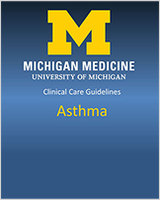From: Pharmacologic Therapy: Managing Exacerbations of Asthma

NCBI Bookshelf. A service of the National Library of Medicine, National Institutes of Health.
Assessment depends on physical examination rather than objective measurements. Use of accessory muscles, paradoxical breathing, cyanosis, and a respiratory rate >60 are key signs of serious distress.
Objective measurements such as oxygen saturation of <91 percent also indicate serious distress.
Response to beta2-agonist therapy can be variable and may not be a reliable predictor of satisfactory outcome. However, because infants are at greater risk for respiratory failure, a lack of response noted by either physical examination or objective measurements should be an indication for hospitalization.
Use of oral corticosteroids early in the episode is essential but should not substitute for careful assessment by a physician.
Most acute wheezing episodes result from viral infections and may be accompanied by fever. Antibiotics are generally not required.
From: Pharmacologic Therapy: Managing Exacerbations of Asthma

NCBI Bookshelf. A service of the National Library of Medicine, National Institutes of Health.